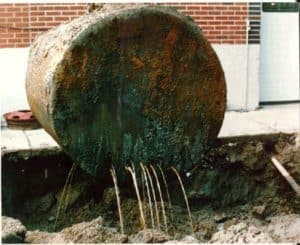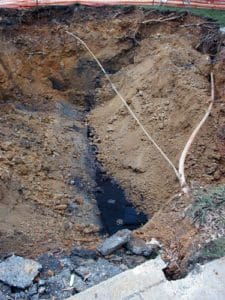
As of August 7, 2017, MassDEP’s closure requirement 310 CMR 80.15 mandates all single-walled steel underground storage tanks (USTs) to be closed-in-place or removed. Covered under this regulation are tanks and associated piping that have more than ten percent of their volume underground and hold petroleum products or hazardous substances listed in the U.S. Comprehensive Environmental Response Compensation Liability Act. With the deadline now less than one year away, it is important to fully understand single-walled USTs, their potentially harmful impact on the environment, and how to properly plan to remove them.
Single-Walled USTs Explained
USTs have been used for many years to store hazardous substances and petroleum products used by a wide variety of businesses. In addition to the tank itself, a “UST system” includes the underground piping that is used to fill the tank and draw product from it. Until the mid-1980s, most USTs were made of bare steel, which is likely to corrode and leak over time. These leaks can exist undetected for years and cause pollution of the surrounding soil and even groundwater. The piping in the system can also leak if not properly installed and maintained. In many cases, contaminant leaks do not get discovered until the owner or operator realizes that a significant amount of product in a tank goes missing or when the tank is removed and contaminants are found in the underlying soil. Another indication of a leaking UST is neighbors complaining of odors in their buildings or experiencing problems with their drinking water.
Leaking USTs, specifically single-walled steel USTs, have caused considerable environmental damage in Massachusetts, affecting public and private water supplies, wetlands, and soil. In some cases, vapors from contaminated soil and water have permeated homes and businesses. Many millions of dollars have already been spent on cleaning up these leaks, but fully protecting public health and the environment from UST leaks relies on removing or closing the storage tanks altogether.
Benefits of the MassDEP UST Removal Requirements

The removal or permanent closure of aging, single-walled USTs benefits many areas of a community. The new MassDEP regulations will benefit human health, ecosystem functions, and land productivity.
Human health benefits are among the top reasons why single-walled USTs are now required to be removed by August 7, 2017. Contaminated well water and vapor intrusion are the most critical threats to human health from failing USTs. Leaks from USTs can endanger residents for miles through contamination of groundwater, and increased cancer rates and blood disorders have been attributed to exposure to petroleum products, which are commonly found in USTs. The petroleum vapors which are emitted are highly flammable and are potentially dangerous when found in people’s homes. Vapors can travel through soil, sewer lines, storm drainage systems, and other pathways to enter homes and other buildings.
Many single-walled USTs are located in old gas stations, providing the opportunity to add aesthetic and ecological benefits to a community. If a UST leaks into soil, the site becomes contaminated and is considered a brownfield. Removing or closing USTs and making the site usable again decreases the need for development elsewhere and helps preserve greenfields, such as pastures or forests. Many old gas stations are situated in quite visible locations within towns or neighborhoods and can be reused for purposes such as gateways, town centers, or pocket parks. Such redevelopment opportunities improve a locality’s appeal and create recreational value.
Removing or closing-in-place single-walled USTs results in several ecological benefits. Preventing leakage of hazardous material can reduce surface water contamination – protecting fish and other wildlife. Below the ground, removing USTs ensures that leaking tanks will not compromise underground aquifers for future generations. In the long run, this will better protect our drinking water’s taste and purity. Removing USTs also greatly improves land use because former UST sites with a “clean bill of health” will be more likely to develop and prosper without environmental restrictions.
Are there any exceptions to the new regulations?

The MassDEP has included exceptions to the UST removal regulations. Tanks are not required to be removed or closed-in-place if they are consumptive use tanks – such as for heating oil in homes – and single-walled tanks that were relined prior to August 8, 2007 in accordance with API 1631. For these relined tanks to be exempt, the owner or operator must possess a permit and approval issued by the head of the local fire department, or a current legally valid warranty for relining. Other exceptions to the new regulations include single-walled steel tanks that have been wrapped with fiberglass, aramid, carbon fiber, or plastic compounds. It is important to note that single-walled steel tanks that are temporarily out-of-service are NOT exempt from the closure requirement, even if they are consumptive tanks for onsite usage. USTs that are not actively used or temporarily out of service are considered abandoned and must be removed or closed-in-place by August 7, 2017.
MassDEP’s UST closure regulation allows tanks to be permanently closed-in-place only if they cannot be removed from the ground without removing a building, or the removal would endanger the structural integrity of another UST, structure, underground piping, or underground utilities. When closing a tank in place, it is required to clean all contaminants out of the tank to prevent future leaks.
In Conclusion
Meeting MassDEP’s closure requirements means more than just being up to code. Removing hazardous USTs benefits everyone involved. It improves a property’s environmental footprint, removes high risk conditions, and reduces an owner’s environmental liability. Compared to the cost of cleaning up hazardous materials after a UST leak, removing a single-walled UST is well worth it. There is only one year left to comply with the MassDEP UST regulations, so it is imperative to start planning now to remove or close-in-place your single-walled USTs.
Please feel free to contact us for any questions on MassDEP’s requirement or for assistance with UST removals and closures.
